Pendergast T., Pendergast S. St. James Encyclopedia of Popular Culture. Volume 1: A-D
Подождите немного. Документ загружается.

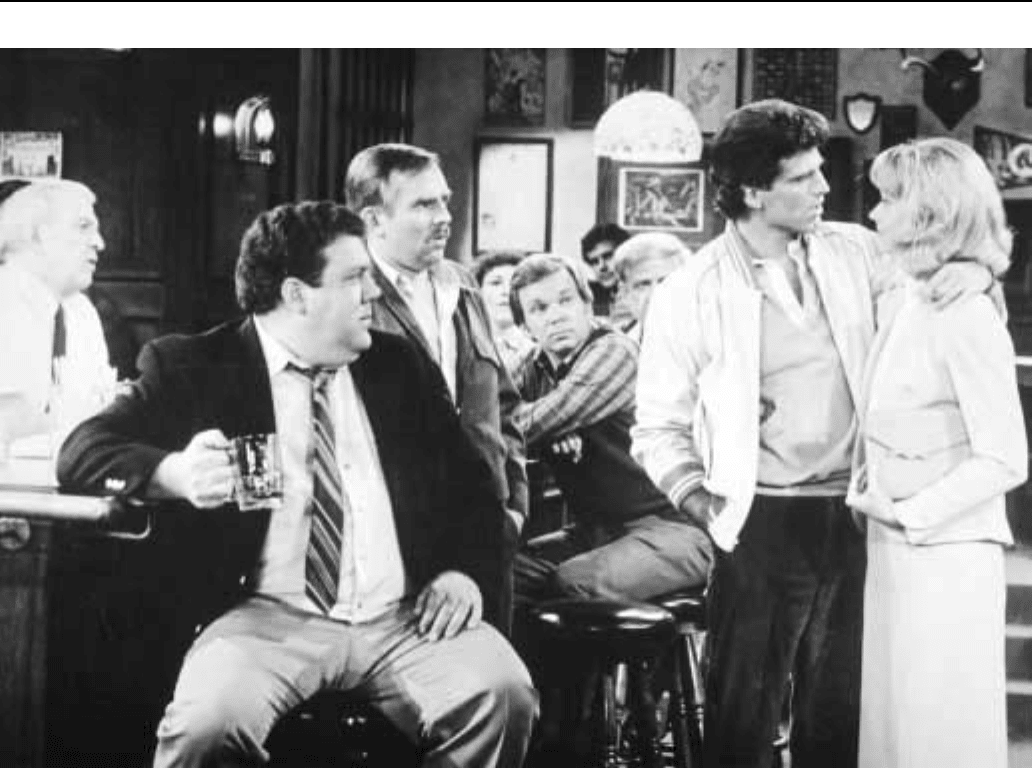
CHEERSENCYCLOPEDIA OF POPULAR CULTURE
489
Ted Danson (second from right) and Shelley Long (right) with the rest of the cast in a scene from the sitcom Cheers.
devised one prank which ended with Cliff, Carla, Norm, and Woody
on an endless cross-country bus trek. The sadism reached its zenith
during a petty rivalry throughout the run of the series with a
competing bar, Gary’s Olde Time Tavern. The feud culminated
during the final season, when the Cheers gang convinced the smug
Gary that an investor would pay him $1 million for his land. Gary
gleefully took a wrecking ball to his establishment.
Cheers ended in 1993 after 11 seasons and 269 episodes. Series
co-creators Glen and Les Charles had once confessed their ideal
Cheers ending: Sam and Diane admit they can’t live with or without
each other and take each other’s life in a murder-suicide. In the actual
finale, Diane did return to the bar, contemplating a reconciliation with
Sam, but the two finally realized they were no longer suitable for each
other. In other developments, upwardly mobile Rebecca impulsively
married a plumber, Cliff won a promotion at the post office, and—
miracle of miracles—Norm finally got a steady job. In the last
moments of the series, the regulars sat around the bar to discuss the
important things in life. As the show faded out one final time, Sam
walked through the empty bar, obviously the most important thing to
him, at closing time.
There has been no consensus as to the best single episode of
Cheers. Some prefer the Thanksgiving episode at Carla’s apartment,
ending in a massive food fight with turkey and all the trimmings in
play. Others recall Cliff’s embarrassing appearance on the Jeopardy!
game show, with a cameo from host Alex Trebek. There was also the
penultimate episode, where the vain Sam revealed to Carla that his
prized hair was, in fact, a toupee. Perhaps the finest Cheers was the
1992 hour-long episode devoted to Woody’s wedding day, a classic,
one-set farce complete with a Miles Gloriosus-like soldier, horny
young lovers, and a corpse that wouldn’t stay put.
Cheers was inspired by the BBC situation comedy Fawlty
Towers (1975, 1979), set at a British seaside hotel run by an
incompetent staff. That show’s creator/star, John Cleese, appeared on
Cheers in an Emmy-winning 1987 cameo as a marriage therapist who
went to great lengths to convince Sam and Diane that they were
thoroughly incompatible. Co-creator James Burrows was the son of
comedy writing great Abe Burrows, responsible for the long-running
1940s radio comedy Duffy’s Tavern (‘‘where the elite meet to eat’’), a
program set in a bar which was also noted for its eccentric characters
and top-notch writing.
Grammer reprised his role of Frasier Crane in the spin-off series
Frasier, which debuted in the fall of 1993 to high ratings and critical
acclaim. The series won Best Comedy Emmy awards during each of
its first five seasons.
—Andrew Milner
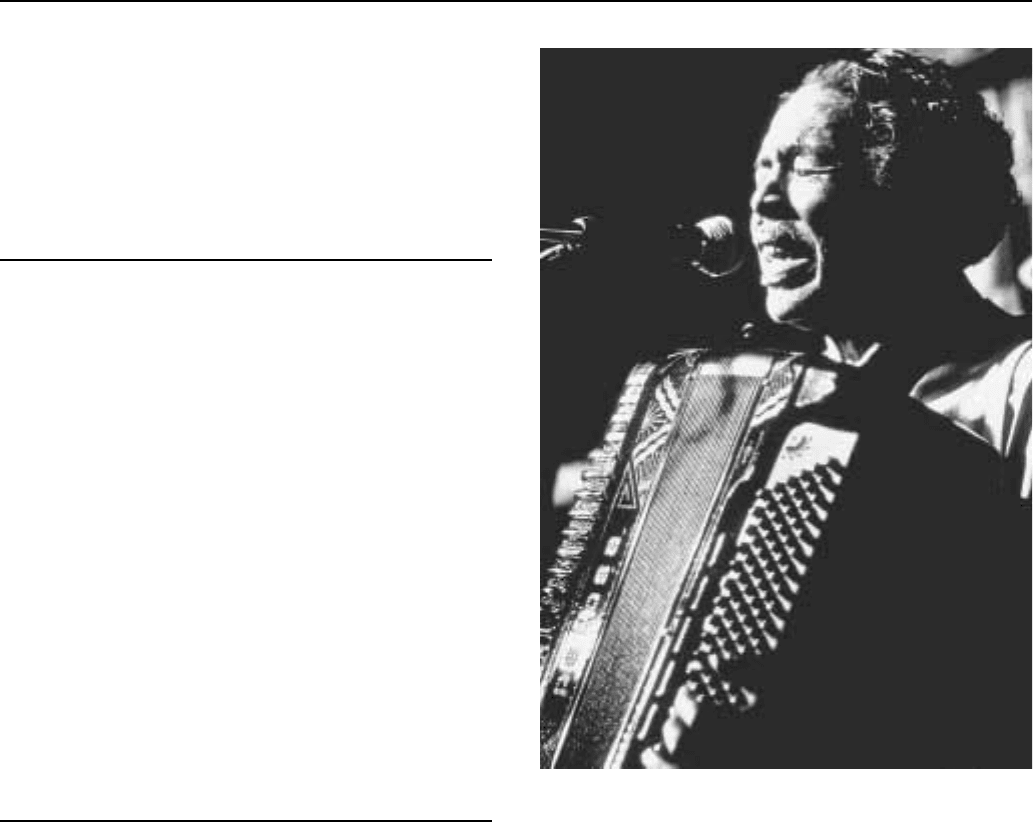
CHEMISE ENCYCLOPEDIA OF POPULAR CULTURE
490
FURTHER READING:
Bianculli, David. Teleliteracy. New York, Ungar, 1993.
Javna, John. The Best of TV Sitcoms: The Critics’ Choice: Burns and
Allen to the Cosby Show, the Munsters to Mary Tyler Moore. New
York, Harmony Books, 1988.
Chemise
Fashion designer Cristobal Balenciaga’s ‘‘chemise’’ dramati-
cally altered womenswear in 1957. Since Christian Dior’s New Look
in 1947, women wore extremely narrow waists, full wide skirts, and
fortified busts. The supple shaping of Balenciaga’s chemise, which
draped in a long unbroken line from shoulder to hem, replaced the
hard armature of the New Look. The chemise was a hit not only in
couture fashion, where Yves Saint Laurent showed an A-line silhou-
ette in his first collection for Dior, but also in Middle America, where
Americans copied the simple shape which required far less construc-
tion and was therefore cheaper to make. Uncomfortable in the body
conformity of the New Look, women rejoiced in a forgiving shape
and the chemise, or sack dress, became a craze. The craze was
parodied in an I Love Lucy episode in which Lucy and Ethel pine for
sack dresses but end up wearing feed sacks.
—Richard Martin
F
URTHER READING:
Chappell, R. ‘‘The Chemise—Joke or No Joke . . . ’’ Newsweek.
May 5, 1959.
Chenier, Clifton (1925-1987)
Although he passed away in the late 1980s, Clifton Chenier
remains the undisputed King of Zydeco. It was Clifton Chenier who
took the old dance music of the rural Louisiana Creoles and added
blues, soul, and country and stirred it all up until it became what we
now call zydeco. His name was virtually synonymous with this type
of music, and he became the most respected and influential zydeco
artist in the world. Chenier popularized the use of the big piano key
accordion, which allowed him to play a diversity of styles within the
expanding zydeco genre. He pushed the envelope with energetic
renditions of French dance standards or newer tunes transformed
through zydeco’s characteristic syncopated rhythms and breathy
accordion pulses. Chenier assembled a band of musicians who were
not just good but were the best in the business; they were a close-knit
group that became legendary for high intensity concerts lasting four
hours straight without a break. And there at the helm was Chenier,
gold tooth flashing like the chrome of his accordion, having the time
of his life.
Clifton Chenier was born on June 25, 1925 into a sharecropping
family near Opelousas, Louisiana. He became dissatisfied early on
with the farming life, and headed west with his brother Cleveland to
work in the oil refineries around Port Arthur, Texas. Having learned
from his father how to play the accordion, Chenier decided to attempt
a transition toward performing as a professional. Driving a truck
during the day and playing music at night, Chenier, along with his
Clifton Chenier
brother on rubboard, soon became a popular attraction in local
roadhouses. Often the pair comprised the entire band, and this was
zydeco in its purest form, an extension of the earlier French ‘‘la-la’’
music played at Creole gatherings throughout southwest Louisiana,
now taken to new heights and amplitude for a wider audience.
Chenier credits Rhythm and Blues (R & B) artist Lowell Fulson with
showing him how to be a good performer, always mixing it up and
pleasing the crowd—these lessons stayed with him for the rest of his
career. One of his earliest recordings, ‘‘Ay-Tete-Fee’’ became a hit
record in 1955.
During the early 1960s, Chenier began recording albums for
Chris Strachwitz’s west coast Arhoolie Records, where he eventually
became that label’s biggest seller. His first Arhoolie album, Louisiana
Blues and Zydeco, was a hard-fought compromise between the
producer’s desire for traditional zydeco, and Chenier’s wish to cross
over into soul and the potentially even more lucrative R & B. The final
version of the album represented a mixture of these two directions and
included for the first time on record a blues number sung in French.
Following that release, Chenier’s popularity soared, and a frenetic
schedule of touring ensued. Over the next few years, Clifton Chenier
would realize the wisdom of Strachwitz’s insistence on sticking close
to unadulterated zydeco, which was already a musical gumbo of
various ingredients, and he became more of a traditionalist himself,

CHERRY AMESENCYCLOPEDIA OF POPULAR CULTURE
491
championing Creole culture and the French language wherever
he played.
All through the 1970s Chenier and his Red Hot Louisiana Band
traveled the ‘‘crawfish circuit’’ between New Orleans and Houston,
playing in parking lots, in clubs and bars, and in Catholic church halls
where zydeco dances were sponsored with increasing frequency. This
kept the music rooted in its place of origin, and served to accentuate
the rising awareness of Creole ethnic identity. When touring further
afield, he became a regular attraction at blues festivals around the
country and even made a successful sweep through Europe. It was
about this time that he began wearing a crown on stage, dubbing
himself the ‘‘King of Zydeco.’’ His musical performances were
featured in several documentary films, including Hot Pepper and J’ai
Ete au Bal. In 1984, Chenier won a Grammy Award for the album I’m
Here, and was now a nationally, and even internationally recognized
musician. But his health had gone downhill. Plagued by poor circula-
tion, he was diagnosed with diabetes and had portions of both legs
amputated. After a final, tearful performance at the 1987 Zydeco
Festival in Plaisance, Louisiana, he canceled a scheduled tour due to
illness, and on December 12, 1987, at the age of 62, Clifton died in a
Lafayette hospital. His legacy lives on, as does his fabled Red Hot
Louisiana Band, now led by son C.J. Chenier, an emerging zydeco
artist in his own right.
There has never been anyone, before or since, who could play the
accordion like Clifton Chenier. While his vocal renditions of songs
were truly inspired, his voice always served as accompaniment to the
accordion, rather than the other way around. Besides having talent
and the gift of making music, he was able to establish a warm and
unaffected rapport with his audience. He knew who he was, he loved
what he was doing, and he genuinely enjoyed people. Fans and critics
alike are unreserved in their emphatic assessment of Clifton Chenier’s
artistry and his place in the annals of popular music. And musicians in
the Red Hot Louisiana Band fondly recall the feeling of playing with
this soulful master who had so much energy and who injected such
pure feeling into his music. As former member Buckwheat Zydeco
put it, ‘‘Clifton Chenier was the man who put this music on the map.’’
—Robert Kuhlken
F
URTHER READING:
Broven, John. South to Louisiana: The Music of the Cajun Bayous.
Gretna, Louisiana, Pelican Publishing, 1983.
Tisserand, Michael. The Kingdom of Zydeco. New York, Arcade
Publishing, 1998.
Cher
See Sonny and Cher
Cherry Ames
Packed with wholesome values and cheerfulness, the Cherry
Ames nursing mystery series was popular with girls in the mid-
twentieth century. Cherry, a dark-haired, rosy-cheeked midwestern
girl, was always perky and helpful, ready to lend a hand in a medical
emergency and solve any mysteries that might spring up along the
way. The books never claimed to have literary quality. Their creator,
Helen Wells, admitted they were formulaic—not great literature, but
great entertainment.
The series consisted of 27 books published by Grosset and
Dunlap between 1943 and 1968, authored by Helen Wells and Julie
Tatham. Aggressively marketed to girls, the books contained all sorts
of consumer perks: the second book in the series was offered free with
the first, and each book showed a banner on the last page advertising
the next exciting adventure. The first 21 volumes were issued in
colorful dust jackets showing Cherry in her uniform, proclaiming ‘‘It
is every girl’s ambition at one time or another to wear the crisp
uniform of a nurse.’’ (Indeed, this uniform was described over and
over, along with Cherry’s off-duty snappy outfits.) Early copies in the
series had yellow spines, but the format was quickly changed to green
spines, probably to avoid confusion with the ubiquitous Nancy Drew
books. There was also a companion volume written by Wells in 1959,
entitled Cherry Ames’ Book of First Aid and Home Nursing.
In the early years, the novels were patriotic, pro-nursing tales in
which Cherry called for other girls to join her and help win World War
II. The later books were mysteries, with Cherry as a girl sleuth. Titles
followed the format of Cherry Ames, Student Nurse and included
Cherry Ames, Cruise Nurse, Cherry Ames, Chief Nurse, Cherry
Ames, Mountaineer Nurse, among many others. Cherry’s nursing
duties brought her to such exotic locales as a boarding school, a
department store, and even a dude ranch.
Wells (1910-1986), the creator of the series and author of most
of the books, was no stranger to girls’ series—she was also the author
of the Vicki Barr flight attendant series and other books for girls.
Tatham (1908—), wrote a few books in the middle of the series.
Under the pseudonym Julie Campbell she also authored both the
Trixie Belden and Ginny Gordon series.
The Cherry Ames series became internationally popular, with
editions published in England, France, Italy, the Netherlands, and
Japan. In England, books spawned a set of Cherry Ames Girls’
Annuals. There was a Parker Brothers board game produced in 1959,
‘‘Cherry Ames’ Nursing Game,’’ in which players vie to be the first to
complete nursing school.
By the 1970s, the Cherry Ames books were out of print and were
being phased out of libraries. The character had a rebirth in the 1990s,
however, when author and artist Mabel Maney created a series of
wickedly funny gay parodies of the girl-sleuth series books, bringing
out their (almost certainly unintentional) lesbian subtext. In her first
book, The Case of the Not-So-Nice Nurse, the ‘‘gosh-golly’’ 1950s
meet the ‘‘oh-so-queer’’ 1990s when lesbian detectives ‘‘Cherry
Aimless’’ and ‘‘Nancy Clue’’ discover more than just the answer to
the mystery.
—Jessy Randall
F
URTHER READING:
Mason, Bobbie Ann. The Girl Sleuth: A Feminist Guide. New York,
Feminist Press, 1975.
Parry, Sally E. ‘‘‘You Are Needed, Desperately Needed’: Cherry
Ames in World War II.’’ Nancy Drew and Company: Culture,
Gender, and Girls’ Series. Edited by Sherrie A. Inness. Bowling
Green, Ohio, Popular Press, 1997.

CHESSMAN ENCYCLOPEDIA OF POPULAR CULTURE
492
Chessman, Caryl (1921-1960)
In 1948, a career criminal named Caryl Chessman was charged
with being a ‘‘red light bandit’’ who raped and robbed couples in
lovers’ lanes near Los Angeles. Chessman was sentenced to death for
kidnapping two of the victims. His 12-year effort to save himself from
California’s gas chamber intensified the debate over capital punish-
ment. Chessman was successful in persuading various judges to
postpone his execution. This gave him time to make legal arguments
against his conviction and death sentence and to write Cell 2455
Death Row, an eloquent, bestselling book which purportedly de-
scribed the author’s life and criminal career.
The courts ultimately ruled against Chessman’s legal claims.
Many celebrities opposed his execution, including the Pope and
Eleanor Roosevelt. In February 1960, Chessman was granted a stay of
execution while the state legislature considered California Governor
Edmund Brown’s plea to abolish the death penalty. The Governor’s
effort, however, failed and Chessman was executed on May 2, 1960.
—Eric Longley
F
URTHER READING:
Brown, Edmund G., and Dick Adler. Public Justice, Private Mercy: A
Governor’s Education on Death Row. New York, Weidenfeld and
Nicolson, 1989.
Chessman, Caryl. Cell 2455 Death Row. New York, Prentice-
Hall, 1954.
Kunstler, William M. Beyond a Reasonable Doubt? The Original
Trial of Caryl Chessman. New York, William Morrow and
Company, 1961.
Largo, Andrew O. Caryl Whittier Chessman, 1921-1960: Essay and
Critical Bibliography. San Jose, California, Bibliographic Infor-
mation Center for the Study of Political Science, 1971.
The Chicago Bears
Like their home city, the Chicago Bears are a legendary team of
‘‘broad shoulders’’ and boundless stamina. One of the original
members of the National Football League (NFL), the Bears have
captured the attention of football fans since the heyday of radio. An
organization built on innovation and achievement both on and off the
field, the Bears’ remarkable victories earned them the nickname
‘‘Monsters of the Midway.’’ Bears players from Red Grange to
Walter Payton swell the ranks of the famous in football. By the 1990s
the Bears had achieved more victories than any other team in the NFL,
and have 26 members in the Pro Football Hall of Fame.
In 1920, A.E. Staley, owner of the Staley Starch Works in
Decatur, Illinois, hired 25-year-old George Halas to organize a
professional football team. It was a daunting task. Halas approached
his former boss, Ralph Hay of the Canton Bulldogs, with the idea of
forming a professional football league. On September 17, 1920, Halas
met with 12 other team officials in Ralph Hay’s Humpmobile
dealership in Canton, Ohio, where they created the American Profes-
sional Football Association, the predecessor of the modern National
Football League. Of the 13 teams in the original league, only the
Bears and Cardinals remain in existence.
The Decatur Staleys—as the Bears were first called—played
their first game on October 3, 1920 at Staley Field. The Decatur team
was one of only a few to show a profit in the first year of operation.
Due to a recession in 1921, Staley was forced to withdraw support for
the team; but Halas assumed ownership and transferred the franchise
to Chicago. The team selected Wrigley Field as its home. Halas
compared the rough and tumble stature of his players to the baseball
stars of the Chicago Cubs, and renamed the team the Chicago Bears in
January 1922. The team colors, blue and orange, were derived from
Halas’s alma mater, the University of Illinois.
The first major signing for the team occurred in 1925, when
University of Illinois star Red Grange was hired by Halas. Grange
proved to be a strong gate attraction for the early NFL organization.
Although he only played in several games due to injury, he nonethe-
less managed to draw a game crowd of 75,000 in Los Angeles. During
the 1920s the team was a success on the field and at the gate, posting a
winning season every year except one.
The Bears quickly established a reputation as a tough, brawling
team capturing many hard-fought victories. New and exciting players
typified the team over succeeding seasons. Bronko Nagurski, a
tenacious runner requiring several players to take him down, joined
the illustrious 1930 lineup. An opposing coach was rumored to have
said the only way to stop Nagurshi was to shoot him before he went on
the field. Nagurski’s two-yard touchdown pass to Red Grange beat
Portsmouth in the 1932 championship game, the first football game
played indoors at Chicago Stadium. Sidney Luckman was recruited as
the premiere T-formation quarterback in 1939. With Luckman at
passer, the reinvigorated T-formation decimated the Washington
Redskins in a 73-0 title game rout. The Bears became the ‘‘Monsters
of the Midway,’’ and Luckman the most famous Jewish sports legend.
The fighting power of the Bears was strengthened by the addition of
unstoppable George ‘‘One Play’’ McAfee at halfback. He could score
running, passing, kicking, or receiving. Clyde ‘‘Bulldog’’ Turner was
selected as center and linebacker to assist McAfee. Turner proved to
be one of the fastest centers in NFL history.
Following up-and-down seasons during the 1950s, the Bears
regained notoriety by capturing another NFL title in 1963. This was
the first game broadcast on closed circuit television. The recruitment
of running back Gale Sayers in 1965 revitalized the Bears’ fighting
spirit. Sayers was an immediate sensation, setting an NFL scoring
record in his rookie year, and rushing records in subsequent years.
Sportswriters honored Sayers as the greatest running back in pro
football’s first half century. Standing in the shadow of Gale Sayers
was halfback Brian Piccolo. The two men were the first interracial
roommates in the NFL. Piccolo seldom played until Sayers’s knee
injury in 1968. When Sayers was awarded the George Halas Award
for pro football’s most courageous player in 1970, he dedicated the
award to Piccolo, who was dying of cancer. The bond between
Piccolo and Sayers was the subject of the television movie, Brian’s
Song, as well as several books. The Bears were bolstered by the
daunting presence of premiere middle linebacker Dick Butkus, who
became the heart and soul of the crushing Bears defense. George
Halas announced his retirement in 1968, after 40 seasons, with 324
wins, 15 loses, and 31 one ties. Halas remained influential in the
operation of the Chicago Bears and the NFL until his death in 1983.
The Bears played their final season game at Wrigley Field in
1970, and then moved to Soldier Field. Successive coaches Abe
Gibron, Jack Pardee, and Neil Armstrong produced mediocre seasons
with the Bears during the 1970s. The one bright spot during this
period was the recruitment of Walter Payton. Called ‘‘Sweetness’’

CHICAGO JAZZENCYCLOPEDIA OF POPULAR CULTURE
493
because of his gentle manner, Payton led the NFL in rushing for five
successive years (1976-1980). After four coaching seasons Arm-
strong was replaced by former Bears tight end Mike Ditka. Under
Ditka’s command the Bears began winning again. In 1984, Walter
Payton broke Jim Brown’s career rushing record, and at the end of
1985 the team posted a 15-1 regular season mark, tying an NFL
record. On January 26, 1986, in their first Super Bowl appearance, the
Bears trounced New England 46-10, setting seven Super Bowl
records, including the largest victory margin and most points scored.
The 1990s were a milestone decade for the NFL Chicago
franchise: The team played its 1,000th game in 1993, and was the first
team to accumulate 600 victories. Mike Ditka was replaced as head
coach by Dave Wannstedt in 1993. Following the 1998 season
Wannstedt’s contract was terminated, and Jacksonville Jaguars de-
fensive coordinator Dick Jauron was named head coach. For almost
80 years, the Chicago Bears have been one of the powerhouse teams
in American football. Through all their ups and downs, they have
remained true to the city that has been their home—as a tough, proud,
all-American sports franchise, whose influence continues to be felt
throughout popular culture.
—Michael A. Lutes
F
URTHER READING:
Chicago Bears 1998 Media Guide. Chicago, Chicago Bears Public
Relations Department, 1998.
Mausser, Wayne. Chicago Bears, Facts and Trivia. Wautoma, Wis-
consin, E. B. Houchin, 1995.
Roberts, Howard. The Chicago Bears. New York, G.P. Putnam’s
Sons. 1947.
Vass, George. George Halas and the Chicago Bears. Chicago,
Regnery Press. 1971.
Whittingham, Richard. Bears: A Seventy-Five-Year Celebration.
Rochester, Minnesota, Taylor Publishing, 1994.
———. The Bears in Their Own Words: Chicago Bear Greats Talk
About the Team, the Game, the Coaches, and the Times of Their
Lives. Chicago, Contemporary Books. 1991.
———. The Chicago Bears: An Illustrated History. Chicago, Rand
McNally. 1979.
The Chicago Bulls
One of professional basketball’s dynasty teams, the Chicago
Bulls were led by perhaps the best basketball player ever, Michael
Jordan, from 1984-1993 and 1995-1998. When they began their first
season in 1966, the Bulls were a second-rate team, and continued to be
so, even posting a dismal 27-win record in 1984. That finish gave
them the opportunity to draft the North Carolina shooting guard, and
from then on, with his presence, the Bulls never failed to make the
playoffs. Jordan led the Chicago team to six National Basketball
Association championships, from 1991 to 1993 and again from 1996
to 1998. In the process, the team’s bull emblem and distinctive red and
black colors became as recognizable on the streets of Peking as they
were in the gang neighborhoods of Chicago’s South Side. Jordan
became a worldwide celebrity, better known than President Bill
Clinton. When he retired from basketball on January 13, 1999, his
Chicago news conference was broadcast and netcast live worldwide.
Fellow players Dennis Rodman and Scottie Pippen and team coach
Phil Jackson never became as well known as the legendary Jordan,
but were nonetheless important contributors during the Bulls’
championship years.
—Richard Digby-Junger
F
URTHER READING:
Bjarkman, Peter C. The Encyclopedia of Pro Basketball Team Histo-
ries. New York, Carroll & Graf Publishers, 1994, 98-114.
Broussard, Mark, and Craig Carter, editors. The Sporting News
Official NBA Guide, 1996-97 Edition. St. Louis, The Sporting
News Publishing Co., 1996.
Sachare, Alex, editor. The Official NBA Basketball Encyclopedia.
New York, Villard Books, 1994.
The Chicago Cubs
Secure in their roles as major-league baseball’s ‘‘lovable los-
ers,’’ the National League’s Chicago Cubs have not appeared in a
World Series since 1945 and have not won a World Series title since
1907. Despite a legacy of superstar players including 1990s home-run
hero Sammy Sosa, 1980s MVP Ryne Sandberg, and the legendary
Ernie ‘‘Mr. Cub’’ Banks engaged in the most dramatic home-run race
in the history of baseball. He and St. Louis Cardinals slugger Mark
McGwire battled each other shot for shot throughout the season, with
the Cardinal first-baseman finally slamming 70 home runs to Sosa’s
66. Both players shattered Roger Maris’s long-standing single-season
home run record of 61 while helping to revive the popularity of
baseball, whose status had suffered following the 1994 strike.
—Jason McEntee
F
URTHER READING:
Bjarkman, Peter C., editor. Encyclopedia of Major League Baseball
Team Histories. Westport, Connecticut, Meckler, 1991.
The Chicago Cubs Media Guide. Chicago, Chicago National League
Ball Club, 1991.
Golenbock, Peter. Wrigleyville: A Magical History Tour of the
Chicago Cubs. New York, St. Martin’s Press, 1996.
‘‘The Official Web Site of the Chicago Cubs.’’ http:www.cubs.com.
May 1999.
Chicago Jazz
Although New Orleans is the acknowledged birthplace of jazz,
Chicago is regarded as the first place outside of the South where jazz
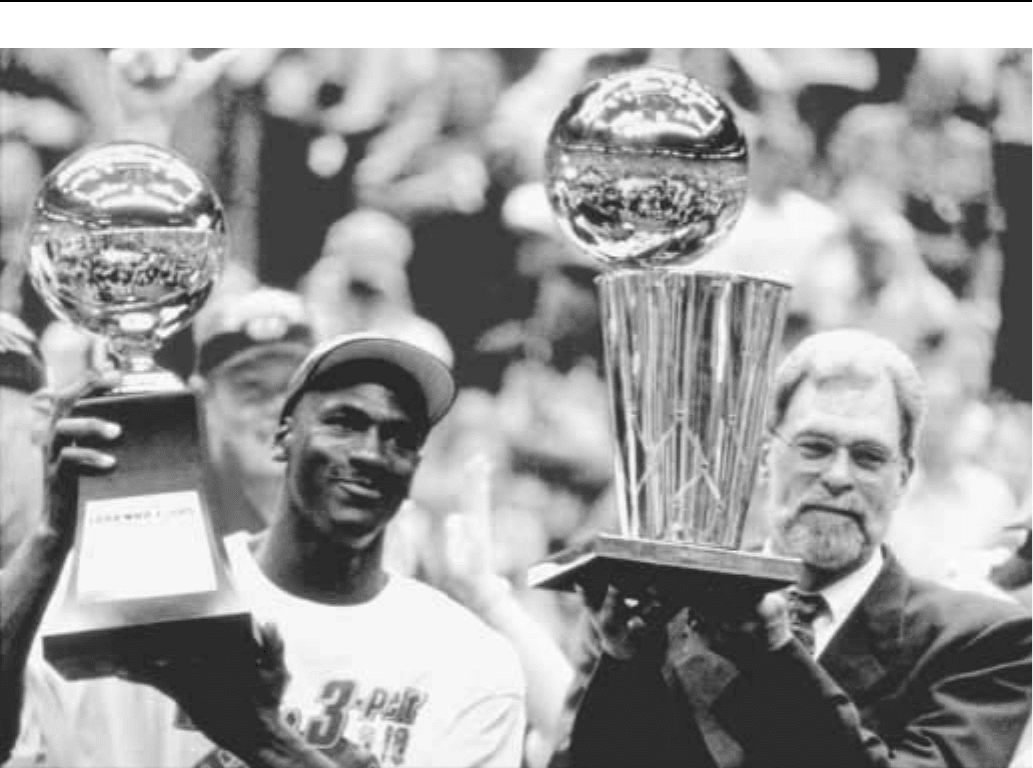
CHICAGO JAZZ ENCYCLOPEDIA OF POPULAR CULTURE
494
Chicago Bulls’ captain Michael Jordan holding his series MVP trophy and head coach Phil Jackson holding the Bulls’ sixth NBA Championship Trophy.
was heard, and New Orleans-style jazz was first recorded in Chicago.
Popular in the 1920s, ‘‘Chicago Jazz’’ refers to a white style of music,
closely related to New Orleans Jazz, in which soloists were more
prominent than the ensemble. The music is also tighter or less
rhythmically realized than the New Orleans style.
When World War I increased employment opportunities for
African Americans outside the South, Chicago became a center of the
black community. Jazz moved to Chicago to fill the need for familiar
entertainment. From the black neighborhoods, jazz moved into the
white areas of Chicago, where young Chicago kids were fascinated
with the new sounds.
The Original Dixieland Jazz Band, a group of white New
Orleans musicians who were the first band to record jazz, included
Chicago musicians for their famous appearance at the Friar’s Inn.
That appearance and their 1917 jazz recording increased its visibility
and attracted a large following for the new music. The New Orleans
Rhythm Kings, an influence on the great Bix Beiderbecke, followed
in 1922 but were no match for King Oliver’s Creole Jazz Band, which
Oliver had formed in New Orleans and taken to Chicago in 1918,
where Louis Armstrong joined in 1922. The Creole Jazz Band
recorded the most significant examples of New Orleans-style jazz.
King Oliver’s band brought African-American jazz to Chicago
and soon attracted a following comparable to that of rock stars today.
Armstrong often played at more than one club in a night. Other New
Orleans greats who came to Chicago in the 1920s included Sid-
ney Bechet, both Johnny and Baby Dodds, Jimmy Noone, and
Freddie Keppard.
Banjoist Eddie Condon (1905-1973) is considered the leader of
the Chicago School, carrying on battles against the boppers, whom he
considered to have spoiled jazz. His musicians included cornetist
Jimmy McPartland (1907-1991), Bud Freeman, Frankie Teschemacher,
and Red McKenzie. This was the core of the Austin High Gang, the
core of the Chicago Jazz movement. The first recording of the
Chicago style was on December 10, 1927. But Condon says that they
were just a bunch of guys who happened to be from Chicago. Condon
pioneered multi-racial recordings, getting many of the New Orleans
musicians together with white musicians.
Jimmy McPartland (1907-1991), the other link in the Chicago
Jazz School, was the center of the Austin High Gang. He learned the
solos note for note of the New Orleans Rhythm Kings and then copied
Bix Beiderbecke’s work. He even replaced Bix in the Wolverines.
McPartland carried the message of classic Dixieland cornet around
the world and remained associated with the Chicago Jazz style until
his death.
—Frank A. Salamone
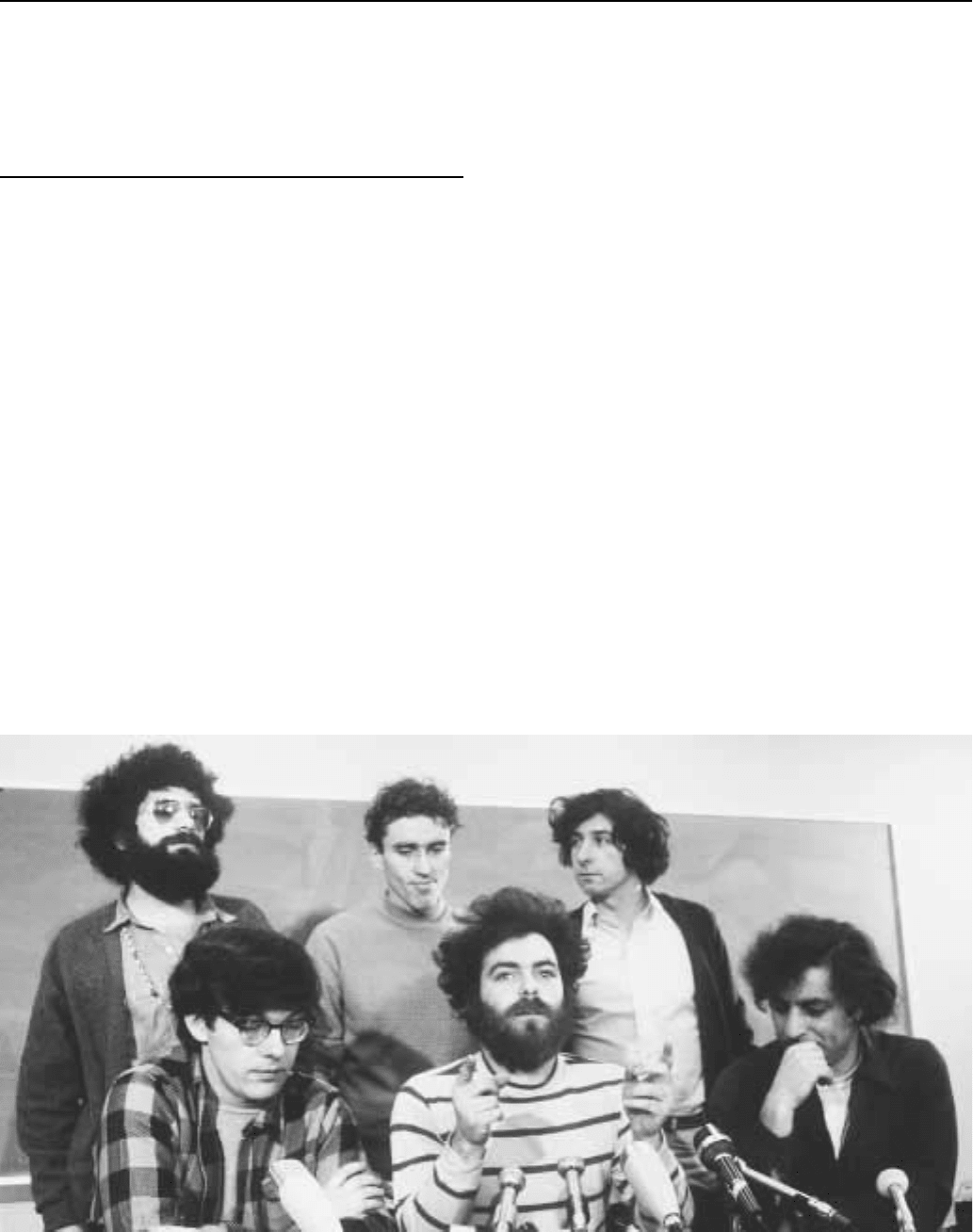
CHICAGO SEVENENCYCLOPEDIA OF POPULAR CULTURE
495
FURTHER READING:
Ian Carr, et al. Jazz: The Rough Guide. London, Rough Guides, 1995.
The Chicago Seven
It was violent clashes between anti-war protesters and police
during the Chicago Democratic Convention of 1968 that created the
Chicago Seven’s place in political and cultural history. The seven
political radicals were indicted for the so-called ‘‘Rap Brown’’ law,
which made it illegal to cross state lines and make speeches with the
intent to ‘‘incite, organize, promote, and encourage’’ riots, conspira-
cy, and the like. There were originally eight defendants: David
Dellinger, a pacifist and chairman of the National Mobilization
against the Vietnam War; Tom Hayden and Rennie Davis, leaders of
the Students for a Democratic Society (SDS); Abbie Hoffman and
Jerry Rubin, leaders of the Youth International Party—or ‘‘Yippies;’’
John Froines and Lee Weiner, protest organizers; and Bobby Seale,
co-founder of the Black Panther Party. The riots and subsequent trial
triggered more massive and violent anti-war demonstrations around
the country. The conflict in Chicago, however, was not simply about
America’s involvement in Vietnam. The conflict was also about the
political system, and to those millions who watched the confronta-
tions between police and demonstrators on television, it marked a
crisis in the nation’s social and cultural order.
The demonstrators, many of whom had been involved with civil
rights battles in the South, saw their protests at the convention as an
opportunity to draw media attention to their cause. Following the
murders of Martin Luther King Jr. and Robert Kennedy, many
protesters were anxious to become more confrontational and militant
Members of the Chicago Seven: (back row from left) Lee Weiner, Bob Lamb, Tom Hayden, (front row from left) Rennie Davis, Jerry Rubin, and Abbie
Hoffman.
with political and police forces. The Yippies, led by Hoffman and
Rubin, looked to harness the energy of America’s rebellious youth
culture, with its rock music and drugs, to bring about social and
political change. The Yippies were formed solely for the purpose of
confronting those involved with the Democratic Convention. They
believed that the mass media and music could lead young people to
resist injustices in the political system. Hoffman and Rubin, the most
flamboyant and disruptive participants in the court trial—after Seale
was removed—did not believe that the ‘‘New Left’’ would be able to
bring about change through rational discourse with existing powers.
Hence, they led a movement which relied upon guerrilla theater, rock
music, drug experiences, and the mass media to broadcast their
agenda of social revolution to a generation of alienated young people
brought up on television and advertising. Influencing policies or
candidates was not the aim behind the radicalism of the Chicago
Seven. Rather, they worked to reveal the ugliness of a country full of
poverty, racism, violence, and war through a confrontation with the
armed State. The fact that their actions took place in America’s
second largest city, during a nationally televised political convention,
only intensified their message of resistance and rejection.
Chicago mayor Richard Daley and his police force characterized
the demonstrations as attacks upon their city and the law. They
viewed the Chicago Seven and the national media as outside agitators
who trampled on their turf. The Walker Report, however, which was
later commissioned to investigate the events of the convention week,
concluded that the police were responsible for much of the violence
during the confrontations. Perhaps the most memorable statement
about the events surrounding the rebellion were uttered by Mayor
Daley at a press conference during the convention: ‘‘The police-
man isn’t there to create disorder. The policeman is there to
preserve disorder.’’
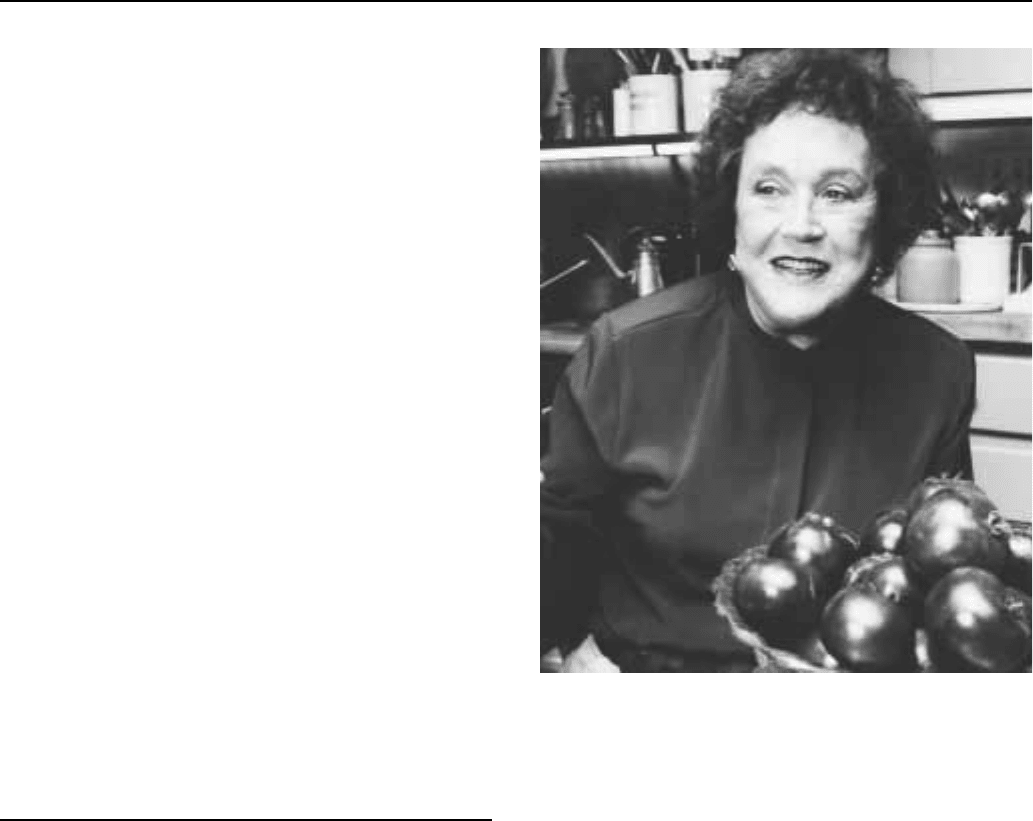
CHILD ENCYCLOPEDIA OF POPULAR CULTURE
496
The trial of the eight defendants began in September of 1969 and
lasted for five months. Judge Julius Hoffman inflexibility and obvi-
ous bias against the defendants provoked righteous anger, revolution-
ary posturing, guerrilla theater, and other forms of defiant behavior
from the defendants. Bobby Seale’s defiant manner of conducting his
own defense—his attorney was in California recuperating from
surgery—resulted in his spending three days in court bound and
gagged. Judge Hoffman then declared his case a mistrial and sen-
tenced him to four years in prison for contempt of court. Hence, the
Chicago Eight became the Chicago Seven. William Kunstler and
Leonard Weinglass were the defense attorneys. Judge Hoffman and
prosecutor Thomas Foran constantly clashed with the defendants who
used the court as a setting to continue to express their disdain for the
political and judicial system. In February, all of the defendants were
acquitted of conspiracy but five were found guilty of crossing state
lines to riot. Froines and Weiner were found innocent of teaching and
demonstrating the use of incendiary devices. An appeals court over-
turned the convictions in 1972, citing procedural errors and Judge
Hoffman’s obvious hostility to the defendants.
—Ken Kempcke
F
URTHER READING:
Epstein, Jason. The Great Conspiracy Trial: An Essay on Law,
Liberty, and the Constitution. New York, Vintage Books, 1971.
Farber, David. Chicago ’68. Chicago, University of Chicago
Press, 1988.
Hayden, Tom. Trial. New York, Holt, Rinehart, and Winston, 1970.
Schultz, John. The Chicago Conspiracy Trial. New York, Da Ca-
po, 1993.
Child, Julia (1912—)
Julia Child made cooking entertainment. A well-bred, tall,
ebullient woman who came to cooking in the middle of her life, Julia
Child appeared on television for the first time in the early 1960s and
inaugurated a new culinary age in America. Blessed with an ever-
present sense of humor, a magnetic presence in front of the camera,
and the ability to convey information in a thoroughly engaging
manner, Julia Child spirited Americans away from their frozen foods
and TV dinners and back into the kitchen, by showing them that
cooking could be fun.
For someone who would become one of the most recognizable
and influential women in the world, it took Julia Child a long time to
find her true calling. She spent the first 40 years of her life in search of
her passion—cooking—and when she found it, she was unrelenting in
promoting it. But like so many privileged women of her generation,
Julia Child was not brought up to have a career. Born on August 15,
1912 into the conservative affluence of Pasadena, California, Julia
McWilliams was the daughter of an aristocratic, fun-loving mother
and a well-off, community-minded businessman father. Raised in a
close family, who provided for her every need, Julia was a tree-
climbing tomboy who roamed the streets of Pasadena with her passel
of friends. Her childhood was full of mischievous fun, and food
formed only the most basic part of her youth. Her family enjoyed
hearty, traditional fare supplemented by fresh fruits and vegetables
from nearby farms.
Julia Child
By her early teenage years, Julia was head and shoulders taller
than her friends, on her way to becoming a gigantic, rail thin 6 feet 2
inches. Lithe and limber, the athletic teenager enjoyed tennis, skiing,
and other sports, and was the most active girl in her junior high
school. When she graduated from ninth grade, however, her parents
decided it was time for Julia to get a solid education, and so they sent
her to boarding school in Northern California. At the Katherine
Branson School for Girls, Julia quickly became a school leader,
known, as her biographer Noël Riley Fitch has written, for ‘‘her
commanding physical presence, her verbal openness, and her physi-
cal pranks and adventure.’’ As ‘‘head girl,’’ Julia stood out among her
classmates socially, if not intellectually. She was an average student,
whose interests chiefly lay in dramatics and sports and whose greatest
culinary delight was jelly doughnuts. But her education was solid
enough to earn her, as the daughter of an alumna, a place at prestigious
Smith College in Massachusetts.
In her four years at Smith, Julia continued in much the same vein
as in high school. She was noted for her leadership abilities, her sense
of adventure, and, as always, her height. At 6 feet 2 inches, she was
once again the tallest girl in her class. At Smith, she received a solid
education. But, as Julia would later remark, ‘‘Middle-class women
did not have careers. You were to marry and have children and be a
nice mother. You didn’t go out and do anything.’’ And so after
graduation, Julia returned home to Pasadena. After a year, however,
she grew restless and returned to the East Coast, hoping to find a job in
New York City. Sharing an apartment with friends from Smith and
supported mostly by her parents, Julia found a job at Sloane’s, a

CHILDENCYCLOPEDIA OF POPULAR CULTURE
497
prestigious home-furnishing company. She worked for the advertis-
ing manager, learning how to write press releases, work with photog-
raphers, and handle public relations. She loved having something to
do and reveled in the job. Having always been interested in writing,
Julia also began submitting short pieces to magazines such as the
Saturday Review of Literature. Her life now had some larger purpose.
But Julia’s stay in New York would only last a few years.
Unhappy over the breakup of a relationship and worried about her
mother’s health, Julia returned home to Pasadena, where her mother
died two months later. As the oldest child, Julia decided to stay in
California to take care of her father and soon found work writing for a
new fashion magazine and later heading up the advertising depart-
ment for the West Coast branch of Sloane’s. But by the early 1940s,
with America at war, Julia had grown impatient with her leisurely
California life. A staunch Rooseveltian Democrat, Julia wanted to be
a part of the war effort and so applied to the WAVES and the WACS.
But when her height disqualified her from active service, Julia moved
to Washington, D.C., where she began work in the Office of Strategic
Services, the American branch of secret intelligence.
With her gift for leadership, Julia quickly rose in the ranks,
working six days a week, supervising an office of 40 people. She still
dreamed of active service, and when the opportunity arose to serve
overseas, she jumped at the chance. In early 1944, 31-year-old Julia
McWilliams sailed for India. In April, she arrived in Ceylon, where
she went to work at the OSS headquarters for South East Asia.
Although she considered the work drudgery, she loved being in a
foreign country, as well as the urgency of the work at hand. She met
many interesting people, men and women, not the least of whom was
a man ten years older than she, an urbane officer named Paul Child.
Stationed in Ceylon and later in China, Julia and Paul became
good friends long before they fell in love. She was fascinated by his
background—a multilingual artist, he had lived in Paris during the
1920s and was a true man of the world. One of his great passions was
food, and he gradually introduced Julia to the joys of cuisine. In
China, the two friends would eat out at local restaurants every chance
they could. She would later write: ‘‘The Chinese food was wonderful
and we ate out as often as we could. That is when I became interested
in food. There were sophisticated people there who knew a lot about
food . . . I just loved Chinese food.’’
Julia recognized it first—she had fallen in love. It took Paul a
little longer to realize that he was head-over-heels for this tall,
energetic, enthusiastic Californian. In fact, after the war, the two went
their separate ways, only coming together later in California. In their
time apart, Julia had begun perfunctory cooking lessons, hoping to
show off her newfound skills to Paul. By the time they decided to
drive across country together, they knew they would be married. Julia
and Paul Child set up house together in Washington, D.C., awaiting
Paul’s next assignment. When they were sent to Paris, both were ecstatic.
Julia’s first meal upon landing in France was an epiphany. She
later reflected, ‘‘The whole experience was an opening up of the soul
and spirit for me . . . I was hooked, and for life, as it turned out.’’
While settling in Paris, Julia and Paul ate out at every meal, and Julia
was overwhelmed by the many flavors, textures, and sheer scope of
French cuisine. She loved everything about it and wanted to learn
more. In late October 1949, Julia took advantage of the GI Bill and
enrolled at the Cordon Bleu cooking school. It was the first step in a
long journey that would transform both her life and American
culinary culture.
The only woman in her class, Julia threw herself into cooking,
spending every morning and afternoon at the school and coming
home to cook lunch and dinner for Paul. On the side, she supplemen-
ted her schooling with private lessons from well-known French chefs,
and she attended the Cercle des Gourmettes, a club for French women
dedicated to gastronomy. There she met Simone Beck and Louisette
Bertholle. The three soon became fast friends and, after Julia graduat-
ed from Cordon Bleu, they decided to form their own cooking school
geared at teaching Americans in Paris. L’Ecole des Trois Gourmands
was formed in 1952 and was an instant success. Out of this triumvirate
came the idea for a cookbook that would introduce Americans to
French cuisine.
With the help of an American friend, the idea was sold to
Houghton Mifflin. The most popular American cookbooks, The Joy
of Cooking and Fanny Farmer, were old classics geared toward
traditional American fare. Julia envisioned a cookbook that would
capture the American feel of The Joy of Cooking in teaching Ameri-
cans about French cuisine. For the next ten years, Julia and her
companions labored tirelessly over their cookbook. Even when Paul
and Julia were transferred, first to Marseille then to Bonn, Washing-
ton, and Oslo, the Trois Gourmands remained hard at work. Julia was
meticulous and scientific, testing and re-testing each recipe, compar-
ing French food products to American, keeping up with American
food trends, and polishing her writing and presentation style. Less
than a year from the finish, however, Houghton Mifflin suddenly
pulled out and it seemed that the project would never come to fruition.
Then Knopf stepped in and in 1961, shortly after Julia and Paul
returned to the United States for good, Mastering the Art of French
Cooking was released. An immediate success, the cookbook, with its
superb quality, clear and precise recipes, and unique pedagogical
approach to cooking, became the standard against which all other
cookbooks would come to be judged. At 49 years old, Julia Child was
hailed as a great new American culinary voice. In a country where
most people’s meals consisted of canned items, frozen foods, and TV
dinners, the food community hailed her classical training. As Karen
Lehrman wrote in ‘‘What Julia Started,’’ ‘‘In the 1950s, America was
a meat-and-potatoes kind of country. Women did all of the cooking
and got their recipes from ladies’ magazine articles with titles like
‘The 10-Minute Meal and How to Make It.’ Meatloaf, liver and
onions, corned beef hash—all were considered hearty and therefore
healthy and therefore delicious. For many women, preparing meals
was not a joy but a requirement.’’ Julia Child would change all that.
Julia and Paul settled in Cambridge, Massachusetts, a decision
that would ultimately make Julia Child a household name. As the
home of many of the country’s finest institutions of higher learning,
Cambridge boasted the best-funded educational television station,
WGBH. Early in 1962, WGBH approached Julia about putting
together a cooking show. Filmed in black and white in rudimentary
surroundings, the show was a success from the very start. Julia Child
was a natural for television. Although each show was carefully
planned and the meals meticulously prepared, on-air Julia’s easy
going manner, sense of humor, and joie de vivre shone through,
making her an instant hit.
Within a year, Julia Child’s The French Chef was carried on
public television stations around the country and Julia Child was a
household name with a huge following. As Karen Lehrman describes,
‘‘Julia may or may not have been a natural cook, but she certainly was
a natural teacher and comedian. Part of the entertainment came from
her voice alone, which can start a sentence on a bass note and end of
falsetto, and elongate in different keys several seemingly random
words in between. But she also had an exceptional presence, a keen
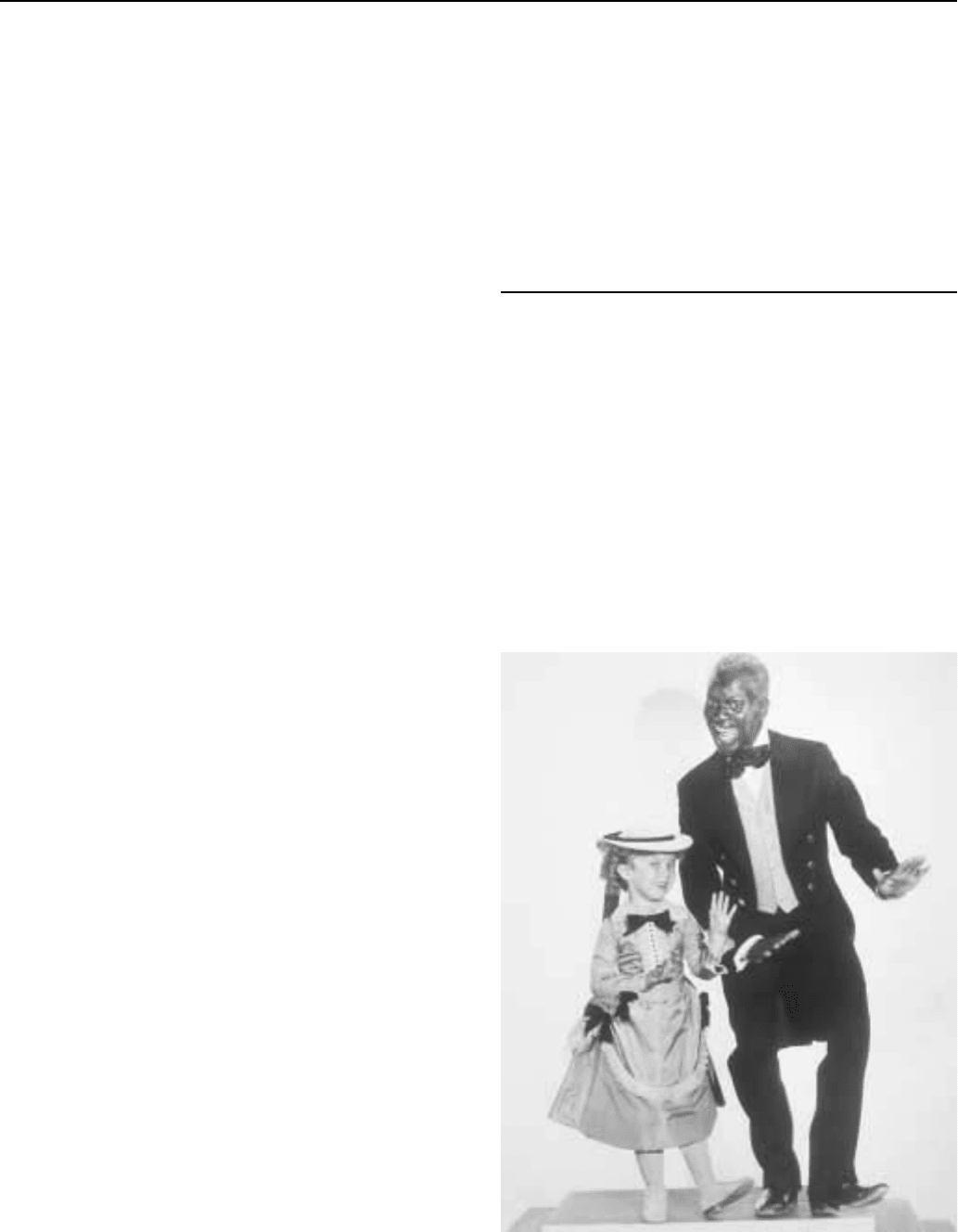
CHILD STARS ENCYCLOPEDIA OF POPULAR CULTURE
498
sense of timing and drama, and a superb instinct for what’s funny.
Most important, she completely lacked pretension: She played her-
self. She made noises (errgh, oomph, pong), called things weird or
silly, clashed pot lids like cymbals, knocked things over, and in
general made quite a mess. ‘When, at the end of the program, she at
last brings the finished dish to the table,’ Lewis Lapham wrote in
1964, ‘she does so with an air of delighted surprise, pleased to
announce that once again the forces of art and reason have triumphed
over primeval chaos.’’’
For the next 30 years, Julia Child would appear on television, but
because she viewed herself as a teacher, only on public television.
Supported by Paul every step of the way, Julia would transform
cooking from a housewife’s drudgery to a joyous event for both men
and women. In doing so, she changed the culinary face of America.
She became a universally recognizable and much loved pop culture
icon. Her shows became the object of kindhearted spoof and satire—
the best of which was done by Dan Ackroyd on Saturday Night Live—
and her image appeared in cartoons. But mostly it was Julia herself
who continued to attract devoted viewers of both sexes, all ages, and
many classes. As Noël Riley Fitch wrote, ‘‘The great American fear
of being outré and gauche was diminished by this patrician lady who
was not afraid of mistakes and did not talk down to her audience.’’
Julia-isms were repeated with glee around the country, such as the
time she flipped an omelet all over the stove and said, ‘‘Well, that
didn’t go very well,’’ and then proceeded to scrape up the eggs and
put them back in the pan, remarking, ‘‘But you can always pick it up if
you’re alone. Who’s going to see?’’ Her ability to improvise and to
have fun in the kitchen made her someone with whom the average
American could identify. As Julia herself said, ‘‘People look at me
and say, ‘Well, if she can do it, I can do it.’’’
As America got turned on to food, be it quiche in the 1970s,
nouvelle cuisine in the 1980s, or organic food in the 1990s, Julia
stayed on top of every trend, producing many more exceptional
cookbooks. The Grande Dame of American cuisine, Julia Child
remains the last word on food in America. Founder of the American
Institute of Wine and Food, Julia Child continues to bring together
American chefs and vintners in an effort to promote continued
awareness of culinary issues and ideas both within the profession—
which, thanks to Julia, is now among the fastest growing in Ameri-
ca—and among the public. Popular women chefs, such as Too Hot
Tamales, Susan Feniger and Mary Sue Miliken, abound on television,
thanks to Julia who, though she did not think of herself as a feminist,
certainly liberated many women through her independence and
passionate commitment to her career. Karen Lehrman has written,
‘‘Julia Child made America mad for food and changed its notions of
class and gender.’’ A uniquely American icon, Julia Child not only
transformed the culinary landscape of this country, but she became a
role model for men and women of all ages and classes.
—Victoria Price
F
URTHER READING:
Child, Julia. Mastering the Art of French Cooking. New York, Alfred
A. Knopf, 1961.
Fitch, Noël Riley. Appetite for Life: The Biography of Julia Child.
New York, Doubleday, 1997.
Lehrman, Karen. ‘‘What Julia Started.’’ U.S. News and World
Report. Vol. 123, No. 11, September 22, 1997, 56-65.
Reardon, Joan. M.F.K Fisher, Julia Child, and Alice Waters: Cele-
brating the Pleasures of the Table. New York, Harmony
Books, 1994.
Villas, James. ‘‘The Queen of Cuisine.’’ Town and Country. Vol.
148, No. 5175, December 1994, 188-193.
Child Stars
In Hollywood, it has been said that beauty is more important than
talent, but youth is most important of all. The image of America
conveyed by the motion picture industry is one of beautiful, young
people in the prime of life. The most youthful of all are the children—
fresh-faced innocents in the bloom of youth transformed into Holly-
wood stars who represent the dreams of a nation. Certainly this was
the case during the Depression, when child stars such as Shirley
Temple, Freddie Bartholomew, and Deanna Durbin were the motion
picture industry’s top box office draws, inspiring a global mania for
child actors. In what has come to be known as the Child Star Era, these
juvenile audience favorites often single-handedly supported their
studios, becoming more famous than their adult counterparts. When
the Golden Age of Hollywood came to an end after World War II, so
did the Child Star Era. But the appeal of child stars remains strong in
Shirley Temple and Bill ‘‘Bojangles’’ Robinson.
